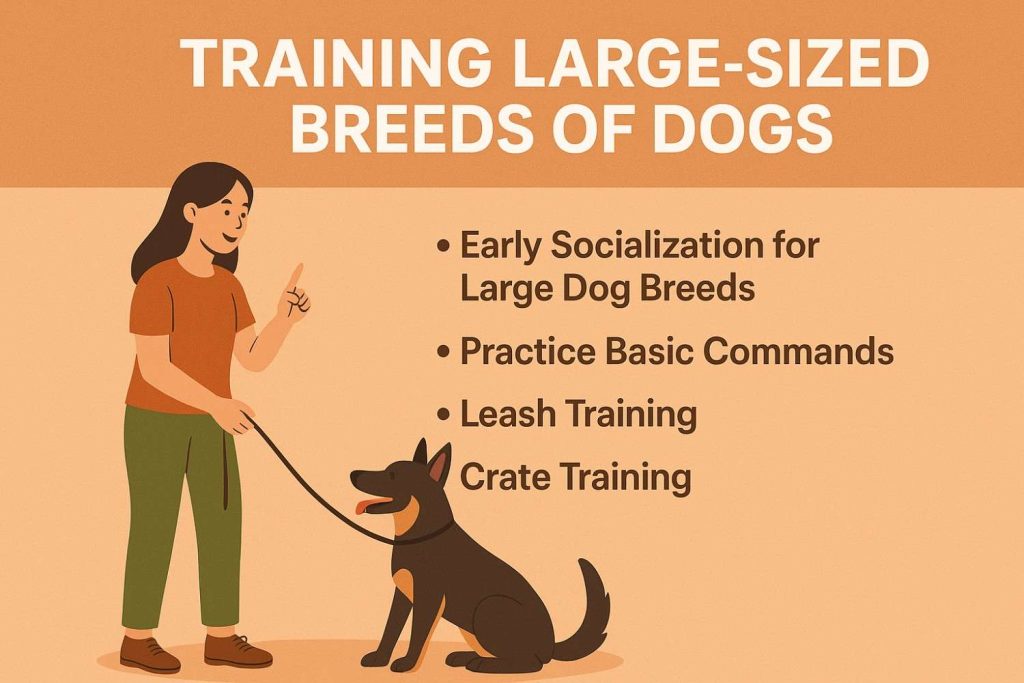Big dog breeds tend to be known for loyalty, guard instincts, and a lovable nature. German Shepherd and Great Dane breeds can be differentiated not only by their stature but also by the unique challenges they pose during training. That friendly chomp a large puppy gives might seem harmless at a glance; however, when this puppy has grown into a 90-pound adult, this can quickly become a problem. Training is not only beneficial for large breeds but also absolutely required to provide both the dog and its owner with a safe environment. The following are a few practical training suggestions to help out.

Begin Early with Socialization
The earlier a big breed pup begins training, the better. Socialization is most important in the first few months of life. Socialize your pup to people, pets, noises, and locations to discourage timid behavior later. Take them out in public places, invite friends home, or enroll in a puppy socialization class. Large breeds that are well-socialized become confident, undisturbed adults who will be a blessing to handle.
Practice Basic Commands
Large dogs require a good grasp of foundational commands such as sit, stay, come, down, and heel. These commands aren’t about illusion or making your dog a film star; they can help keep your dog out of danger. A good recall (the “come” command), for example, can prevent a loose pup from running into traffic. Be consistent. Training sessions should be short, fun, and regular, and always reinforce good behavior with a treat or a pat on the back.
Let’s Emphasize Leash Manners
It can be tiring and even hazardous to have a big dog that pulls while it walks. Training leash manners early helps to keep this issue under control. Start by praising your dog while it walks alongside you calmly. Make use of a large breed harness if need be, but never use gear that hurts. Training your dog to respect your pace and direction makes walking a better experience for both of you.
Oversee Leaping and Physical Play Activities
It can be adorable to have your dog jump up to say hello when they are little, but it can be too much or potentially harmful when they reach maturity. Redirect this behavior by training them to greet guests politely while sitting. It’s the same case with hyper play. Promote soft play and use toys to direct excess energy. It pays to reinforce calm behavior at a young age.
Crate Training for Safety
Crate training is especially beneficial to large dog breeds. A crate is a safe area where a dog can relax and prevent destructive actions in your absence. Choosing a crate that will allow a dog’s ability to stand, turn around, and extend without restriction is crucial. With the use of patience and positive reinforcements, a dog will accept the crate as his or her den and not a punishment.
Mind Games
Big breeds usually possess quick minds to keep up with their large bodies. If they don’t receive adequate mental stimulation, they might get bored and end up chewing, digging, or barking. Puzzle toys, cognitive games, and higher-level training keep them mentally active. Training to perform tricks or doing agility exercises can be a wonderful mental and physical workout too.
Exercise: Building upon Positive Behavior
All big breeds require consistent exercise to keep them in balance. If not, they can become pent-up with excess energy that manifests as negative behaviors. Daily long walks, running, playing a round of fetch, and playing in a safely enclosed yard work wonders. Make the intensity dependent on your dog’s breed. A Labrador Retriever will be happy to indulge in some high- octane games, while a Mastiff can be happy to take shorter, quieter walks.
Establish Clear Boundaries
Because they weigh so much, large breeds require strong boundaries in a home. Decide early where your dog can and can’t go, the furniture, certain rooms, and adhere to it. Training them to respect boundaries serves both to keep your home clean and to prevent a potentially disastrous accident involving a large dog in a small space.
Stay Consistent and Patient
Consistency is most important in training large-breed dogs. If a family member permits jumping while another does not permit it, then a dog will become confused about what is and isn’t acceptable behavior. All family members must enforce the same rules and use the same commands. Training does require time, but if consistent, your large breed will eventually repay you in respect and loyalty.
When to Get Assistance
In some instances, training difficulties demand a professional hand. It’s not a bad idea to seek advice from a certified trainer if aggression, fear, or obstinacy is involved. Big breeds are forceful dogs, and a professional opinion can help them be trained both efficiently and safely.
Closing Reflections
Training a large dog requires a commitment to dedication, patience, and consistency, but has very rewarding results. With proper direction, your large companion can become a gentle giant that improves your life in countless ways. Starting early training, a priority on socialization, reinforcing commands, and both physical and mental exercise will lead your puppy to a successful future. Most importantly, it’s important to keep in mind that training is about developing trust and communication with your dog; the moments they feel a sense of safety and comprehension will lead to them thriving.
Author Bio
Ryan Howard is a social entrepreneur and the founder of Buddy, an AI-powered platform helping pet parents with adoption and lifelong care. Inspired by rescuing a German Shepherd named Nikki, Ryan now shares insights on training, health, and the unique bond between people and their pets.



